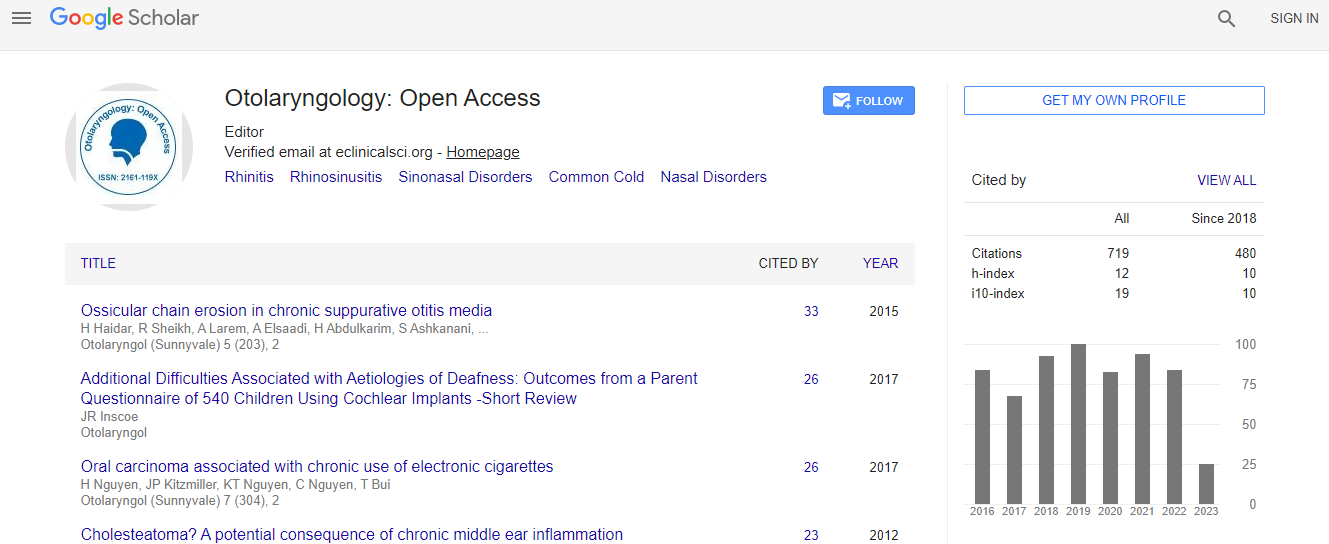Our Group organises 3000+ Global Conferenceseries Events every year across USA, Europe & Asia with support from 1000 more scientific Societies and Publishes 700+ Open Access Journals which contains over 50000 eminent personalities, reputed scientists as editorial board members.
Open Access Journals gaining more Readers and Citations
700 Journals and 15,000,000 Readers Each Journal is getting 25,000+ Readers
Google Scholar citation report
Citations : 925
Otolaryngology: Open Access received 925 citations as per Google Scholar report
Otolaryngology: Open Access peer review process verified at publons
Indexed In
- Index Copernicus
- Google Scholar
- Sherpa Romeo
- Open J Gate
- Genamics JournalSeek
- RefSeek
- Hamdard University
- EBSCO A-Z
- OCLC- WorldCat
- Publons
- Geneva Foundation for Medical Education and Research
- ICMJE
Useful Links
Recommended Journals
Related Subjects
Share This Page
Emergent technologies for oral cancer diagnosis: Are they clinically useful?
International Conference and Exhibition on Otolaryngology
Petra Wilder-Smith
ScientificTracks Abstracts: Otolaryngology
Abstract
A wide range of non-invasive approaches to oral cancer detection are under investigation. Oral cancer is the most common cancer in India, accounting for 40% of all cancers overall, and for more than 50% of all cancers in some areas of the country. In the U.S. the oral cancer rate is also relatively high, especially in African-Americans. Recently a trend has been observed worldwide towards increased incidence of oral cancer among young adults. U.S. survival rate from oral cancer has not improved during the past 50 years. Most oral cancers are detected late, when their prognosis is dire. Yet the prognosis for oral cancer detected at an early stage is very good. Goal is to analyze the principles behind the technologies under development, and to evaluate their clinical effectiveness. Recent clinical diagnostic tools include tolonium chloride, Oral CDx� brush biopsy kits, Vizilite�, salivary diagnostics and imaging devices such as Velscope� , FastEEM4R System, IndentafiR, PS2-oralR, Optical Coherence Tomography and multispectral imaging systems. Photosensitizer-based diagnostics allow for 3-D mapping of large surface areas, and subsequent photodestruction. Limitations include systemic photosensitization, penetration depth, the need for specialized equipment, and lack of specificity. Spectroscopy/fluorescence- based devices include the VelscopeR, FastEEM4R, the IndentafiR, and the PS2-oralR. Preliminary results are encouraging. Challenges include low signal-to-noise ratio, difficulty in identifying source of signals, definitive diagnostic milestones, limited tissue penetration. Early clinical trials using Optical Coherence Tomography have provided encouraging results. Several new optical diagnostic approaches show potential as tools for in vivo oral diagnosis.Biography
Wilder-Smith is Professor and Director of Dentistry at the University of California, Irvine?s Beckman Laser Institute. She is a Fellow of the University of California, Irvine?s Comprehensive Cancer Center, and visiting Professor at Aachen University. Research interests include the use of non-invasive optical techniques such as fluorescence and OCT for oral diagnosis, especially the early detection and monitoring of pre-cancerous and cancerous changes in the mouth. Her work in this field over the past 15 years has resulted in much collaboration and more than 100 publications. She serves on many advisory boards and editorial boards.

 Spanish
Spanish  Chinese
Chinese  Russian
Russian  German
German  French
French  Japanese
Japanese  Portuguese
Portuguese  Hindi
Hindi 
